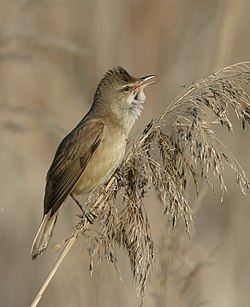Top Qs
Timeline
Chat
Perspective
Acrocephalus (bird)
Genus of birds From Wikipedia, the free encyclopedia
Remove ads
The Acrocephalus warblers are small, insectivorous passerine birds belonging to the genus Acrocephalus. Formerly in the paraphyletic Old World warbler assemblage, they are now separated as the namesake of the marsh and tree warbler family Acrocephalidae. They are sometimes called marsh warblers or reed warblers, but this invites confusion with marsh warbler and reed warbler.
These are rather drab brownish warblers usually associated with marshes or other wetlands. Some are streaked, others plain. Many species breeding in temperate regions are migratory.
This genus has heavily diversified into many species throughout islands across the tropical Pacific. This in turn has led to many of the resulting insular endemic species to become endangered. Several of these species (including all but one of the species endemic to the Marianas and two endemic to French Polynesia) have already gone extinct.
The most enigmatic species of the genus, the large-billed reed warbler (A. orinus), was rediscovered in Thailand in March, 2006; it was found also in a remote corner of Afghanistan in the summer of 2009. Prior to these recent sightings, it had been found only once before, in 1867.
Remove ads
Taxonomy
The genus Acrocephalus was introduced in 1811 by the German naturalist Johann Andreas Naumann and his son Johann Friedrich Naumann.[2][3] The type species was designated as Turdus arundinaceus Linnaeus, 1758, by the English zoologist George Gray in 1840. This is the great reed warbler.[4][5] Many species have a flat head profile, which gives rise to the genus name, Acrocephalus from Ancient Greek akros, "highest", and kephale, "head". It is possible that the Naumanns thought akros meant "sharp-pointed".[6]
Remove ads
List of species in taxonomic order
Summarize
Perspective

The genus contains 42 species of which 6 insular forms are now extinct:[7]
- Basra reed warbler, Acrocephalus griseldis
- Cape Verde warbler, Acrocephalus brevipennis
- Greater swamp warbler, Acrocephalus rufescens
- Lesser swamp warbler, Acrocephalus gracilirostris
- Madagascar swamp warbler, Acrocephalus newtoni
- Seychelles warbler, Acrocephalus sechellensis
- Rodrigues warbler, Acrocephalus rodericanus
- Great reed warbler, Acrocephalus arundinaceus
- Oriental reed warbler, Acrocephalus orientalis
- Clamorous reed warbler, Acrocephalus stentoreus
- Australian reed warbler, Acrocephalus australis
- Millerbird, Acrocephalus familiaris
- † Nightingale reed warbler, Acrocephalus luscinius
- Saipan reed warbler, Acrocephalus hiwae
- † Aguiguan reed warbler, Acrocephalus nijoi
- † Pagan reed warbler, Acrocephalus yamashinae
- † Mangareva reed warbler, Acrocephalus astrolabii
- Nauru reed warbler, Acrocephalus rehsei
- Caroline reed warbler, Acrocephalus syrinx
- Bokikokiko, Acrocephalus aequinoctialis
- Northern Marquesan reed warbler, Acrocephalus percernis
- Tahiti reed warbler, Acrocephalus caffer
- † Moorea reed warbler, Acrocephalus longirostris
- † Garrett's reed warbler, Acrocephalus musae
- Southern Marquesan reed warbler, Acrocephalus mendanae
- Tuamotu reed warbler, Acrocephalus atyphus
- Cook reed warbler, Acrocephalus kerearako
- Rimatara reed warbler, Acrocephalus rimitarae
- Henderson reed warbler, Acrocephalus taiti
- Pitcairn reed warbler, Acrocephalus vaughani
- Black-browed reed warbler, Acrocephalus bistrigiceps
- Moustached warbler, Acrocephalus melanopogon
- Aquatic warbler, Acrocephalus paludicola
- Sedge warbler, Acrocephalus schoenobaenus
- Speckled reed warbler, Acrocephalus sorghophilus
- Blunt-winged warbler, Acrocephalus concinens
- Manchurian reed warbler, Acrocephalus tangorum (sometimes included in A. agricola)
- Large-billed reed warbler, Acrocephalus orinus
- Paddyfield warbler, Acrocephalus agricola
- Blyth's reed warbler, Acrocephalus dumetorum
- Common reed warbler, Acrocephalus scirpaceus
- Marsh warbler, Acrocephalus palustris
Fragmentary fossil remains from the Late Miocene (about 11 mya) of Rudabánya (NE Hungary) show some apomorphies typical of this genus.[8] Given its rather early age (most Passerida genera are not known until the Pliocene), it is not too certain that it is correctly placed here, but it is highly likely to belong to the Acrocephalidae at the least.
Remove ads
References
Further reading
External links
Wikiwand - on
Seamless Wikipedia browsing. On steroids.
Remove ads

